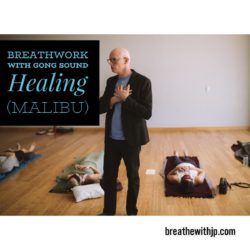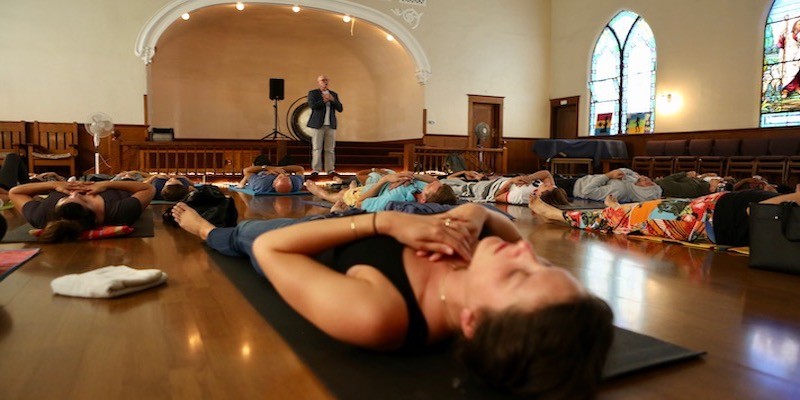Is Breathwork Dangerous?
Here’s a 3-minute youtube video I did on this topic.
Is Breathwork Dangerous?
If you’ve recently come across breathwork, you’re probably wondering if the practice is safe. I understand that. The little voice in your head is probably having a field day telling you all the reasons why you shouldn’t try breathwork!
“This looks stupid”
“What the *#!% is somatic breathwork?”
“It’s just a bunch of new-age woo-woo”
“What I you pass out or have a heart attack?”
Sound familiar?
That’s just the brain doing its job (which is to keep you safe… aka prevent you from trying anything new!). Resistance is normal. The cool thing is you can make an informed decision and override your instincts. Everything you want is on the other side of your comfort zone.
I want you to get the most out of breathwork from the very beginning – so I’ll share everything I know about the safety of breathwork technique. Hopefully, by the end of this article, you will feel pumped to experience what my students say feels like “20 years of therapy without the talking!”
What Happens During Breathwork?
The correct answer depends on the type of breathwork you’re doing.
Breathwork is an umbrella term for a variety of different practices. It’s like saying “fitness.” There are so many different breathwork techniques out there, you may feel confused about what type of breathwork someone is referring to.
I teach a two-part, sometimes called three-part, circular or connected breathing technique. It’s done lying down on your back. NEVER while driving a car. NEVER while in water.
You lie down the entire time because connected breathing is extremely powerful, and it can create an altered state. It can make you naturally high – but the good news is, it won’t destroy your life like recreational drugs. In fact, breathwork will make your life better in so many ways.
Here is one of the things I love about breathwork: We’re not in the jungle doing ayahuasca and puking into a bucket.
You can get off the ride at any time, you’re totally in control of it. You can do breathwork anytime – like in the middle of a Tuesday afternoon when you’re having a bad day (as I have for many years).
While you practice circular breathing technique, you may experience some discomfort as your body gets accustomed to it. It’s called breathWORK for a reason!
During a circular breathwork session, you might experience some of the symptoms below. Some people get freaked out the first time they exhibit symptoms, but I can assure you they are completely normal and harmless:
- A tingly, somatic sensation in your hands, feet, and face
- Dizziness, lightheadedness
- Muscle tightness in the hands and jaw. This is called “tetany” and mostly happens to beginners and people who have a calcium, magnesium, or iron deficiency. It’s not dangerous and goes away once you resume normal breathing.
- Altered states and intense emotional release
If you do experience these symptoms, here’s what you can do:
- Push through the discomfort. This is hard to do when your mind is full of resistance. But it’s also very rewarding, because you get all the benefits while also building resilience. Just tell yourself “Shut up and breathe” until your mind lets go of fear, panic, and somatic sensations. This is what I did every time during the first five years of practicing breathwork.
Alternatively…
- Slow down your breathing and rebalance. As I said before, you are in control. You can always pace yourself during this practice. Take a deep slow breath through your nose and exhale slowly until you feel ready to start circular breathing again.
Is Circular Connected Breathwork Dangerous?
I am NOT a doctor, a scientist, or a guru. I’m just a former celebrity personal trainer who learned this incredible breathwork technique that changed EVERY AREA OF MY LIFE. I then felt the calling to share this with as many people as possible to help them transform their lives.
There have been zero reported cases in the research or literature of any reported incidents of conditions like strokes, heart attacks, etc occurring from breathwork. Zero.
In over ten years of teaching breathwork and guiding thousands of people through sessions, I’ve never once seen anything bad happen. Never. Not once.
The biggest “danger” of doing breathwork technique is experiencing the distress of processing your feelings and traumas. I have seen people freak themselves out. Because they feel things in their body they’ve never felt, or have a huge unexpected emotional release. I haven’t however seen anything harmful happen to anyone.
Breathwork is not more dangerous than riding a bicycle. An average of 800 people a year die riding a bicycle.
It’s not more dangerous than going to the gym. It is estimated that 460,000 people were injured while exercising or using exercise equipment in 2017.
When I was a personal trainer in the gym, I saw people get hurt almost daily. People get hurt in yoga class all the time. People get injured on bicycles. People get totally jacked up just running. We are not afraid of these things though because they are all familiar to us.
So circular breathwork is not dangerous in my experience. However, there is one thing I want you to keep in mind if you try this technique. It’s the one thing I highly recommend you AVOID while practicing this type of breathwork.
Why You Should Never Do Breath Holds During Conscious Connected Breathing
In over a decade of doing breathwork, I’ve done a lot of breath holds. Science is showing the benefits of it more and more every day.
Breath holds, also known as breath retention or breath pauses, mean you voluntarily hold the breath after a full inhalation or a complete exhalation.
During a breath hold, a few changes happen in the body. Oxygen levels decrease, and carbon dioxide levels rise. This changes can influence the autonomic nervous system, leading to shifts in heart rate, blood pressure, and mental states.
Breath holds can be practiced for different durations, ranging from a few seconds to several minutes. The intention behind breath holds can vary based on the breathwork technique you’re doing. Some people use breath holds as a way to explore breath awareness, increase lung capacity, or induce relaxation. Others may use them as a form of meditation or to explore altered states of consciousness.
Wim Hof has made breath holds incredibly popular. The Wim Hof technique has gained a lot of popularity in recent years. It’s based on the Tibetan practice of tummo. The breathing exercises he teaches involve a cycle of deep breaths followed by breath holds, aimed at increasing oxygen levels in the body.
I like what Wim Hof has created and the attention he’s brought to breathwork. As they say, a rising tide floats all boats.
Here’s the thing though. You should not combine breath holds with the technique I teach.
I look at breath holds and circular breathwork as two very different types of practices and tools.
Some people come to my class after they’ve been doing the Wim Hof method for a while. They’re excited to try my technique and I’m excited for them to try it! It’s a very different experience.
However, I always tell them not to do a breath hold at the end of the circular breathwork session. Instead, I have everybody let out a massive yell.
This creates a huge release of energy and possible tension that we’ve built up in our bodies. A breath-hold would be the opposite of that.
More importantly, breath holds can be a bit dangerous.
I know I just spent the previous paragraphs telling you how circular breathwork is safe – and it is. But when you start combining two techniques, you’re doing something different. And when you combine two things that might not don’t go together, you don’t know what the results are going to be.
I recently had a student email me about someone having a possible seizure in their class. After asking a handful of questions, I discovered that they had done a breath hold at the end of the circular breathwork session.
This is why I say that the two methods simply don’t go together.
Biologically speaking, it has to do with the carbon dioxide concentration in your blood. When you do circular breathwork, your carbon dioxide levels drop. While this is not dangerous, you need to be aware that carbon dioxide levels trigger your breathing response. When they’re high, your brain sends a message saying “Okay it’s time to breathe”. It’s like an alarm system for your body.
However…
When you do a long 20 to 30-minute circular breathwork session, the brain might not send that message saying “Okay it’s time to breathe.” The alarm might not function as it usually does. So if you intentionally hold your breath, this may lead to blacking out or even seizures.
It could be a little dangerous. Unfortunately, there are no studies on this yet.
That being said, I have never had anyone experience a seizure in my class. I’ve never seen it in any other classes. But I have heard stories of this happening when people combined breath holds with circular breathwork.
So from where I stand it’s very simple. Don’t combine breath holds with circular breathwork!
Are There Contraindications To Doing Breathwork?
Yes, there are contraindications to doing almost anything.
Most of them exist for protection from getting sued because we live in a litigious society, and people are always looking for a shortcut to cash in. I have everyone sign my waiver for this very reason. Sometimes the waiver can spook people, but it’s no different from the waiver you sign at any gym.
The difference is no one is really that fearful of the gym because we all know what a gym is at this point. We fear the unknown.
Let me say that again because it’s important.
We fear the unknown.
That’s it, plain and simple. It happens when someone hasn’t done breathwork, and they don’t know what it is. Maybe they’ve heard all kinds of crazy stories from a friend.
It creates fear in the mind and the mind is a very powerful thing. The mind’s job is to protect you, to keep you safe at all costs. It doesn’t want you to do anything new whatsoever, because it’s unknown.
You have to override that to grow. You have to do new stuff to grow.
Look, when you do circular breathwork, you’re just lying on the floor breathing a bit more than you normally do. You’ve done way harder stuff in your life than lay on the floor and breathe. I hope.
If you want to have an incredible, transformational experience and change your life, then breathwork is the fastest and most effective way to achieve that. You just need to lie down and breathe. It’s not that hard.
Contraindications for Breathwork:
Breathwork can result in intense physical and emotional release. Therefore, it is not advised for persons with a history of cardiovascular disease, including angina or heart attack, high blood pressure, glaucoma, retinal detachment, osteoporosis, significant recent physical injuries, or surgery.
Breathwork is not advised for persons with severe mental illness or seizure disorders or for persons using major medications. It is also unsuitable for anyone with a personal or family history of aneurysms. Pregnant women are advised against practicing breathwork without first consulting and getting approval from their primary care physician. Persons with asthma should bring their inhaler and consult with their primary care physician.
Is Breathwork Right For You?
The short answer is YES. If you don’t have any major health issues and are willing to put some work into your transformation, breathwork is definitely for you.
We all live busy lives. We all have different degrees of unresolved trauma. We all deserve to love ourselves more and live a purposeful life, instead of merely existing.
Breathwork is the only quick fix I know for inner healing. One session and you’ll know exactly what I mean. Don’t worry, even if you’re skeptical like I was, you will feel different afterwards. The results are undeniable from the first session.
When Is A Good Time To Begin Practicing Breathwork?
Now. Don’t overthink it. It doesn’t matter where you’re at or what’s going on in your life, now is the best time to start.
Breathwork is different for everybody and different every time. I know this sounds like a lot, but don’t take my word for it. Try it and find out for yourself.
EXPERIENCE BREATHWORK NOW
Not more dangerous than riding a bicycle, an average of 800 people a year die riding a bicycle.
Not more dangerous than going to the gym…It is estimated that 459,978 people were injured while exercising or using exercise equipment in 2017.
There have been zero reported cases in the research or literature of any reported incidents of things like strokes, heart attacks, etc happening from Breathwork. Zero.
First let me say upfront that I am NOT a doctor, a scientist, or a guru. I’m just a former celebrity personal trainer who learned this incredible Breathwork technique that changed EVERY AREA OF MY LIFE and then felt the calling to share this with as many people as possible to help them transform their lives.
Secondly, Breathwork is an umbrella term, it’s like saying “Fitness”. There are so many different techniques out there that it gets confusing to know exactly what type of Breathwork the person is referring to.
I teach a two-part, sometimes called 3-part circular or connected breathing technique. It’s done lying down on your back. NEVER driving, NEVER in water. Why, because it’s really powerful, and it can totally create a bit of an altered state. It can make you high, naturally, but the good news is it won’t destroy your life like drugs will, in fact, it’ll make it better in so many ways. Here’s one of the things I love about breathwork…We’re not in the jungle doing ayahuasca puking into a bucket. You can get off the ride at any time, you’re totally in control of it AND you can do it in the middle of a Tuesday afternoon when you’re having a bad day. As I have for many years.
Are there contraindications to doing Breathwork? Yes, there are contraindications to doing almost anything. Some of them are High Blood Pressure, Pregnancy, etc. (I’ll put a full list at the bottom)
Most of them exist for protection from getting sued, because we live in a litigious society happy society and people are always looking for a short cut to cash in. I have everyone sign my waiver for this very reason and sometimes the waiver can spook people, but it’s no different from the waiver you sign at any gym.
The difference is no one is really that fearful of the gym, because we all know what a gym is at this point. We fear the unknown.
Let me say that again because it’s important.
We fear the unknown.
That’s it, plain and simple, because we haven’t done breathwork, and we don’t really know what it is, and maybe you’ve heard all kinds of crazy stories from a friend. It creates fear in your mind and the mind is a very powerful thing. The minds job is to protect you, to keep you safe at all costs. It doesn’t want you to do anything new whatsoever, because it’s unknown. You have to override that to grow, you have to do new stuff to grow. Everything you want is on the other side of your comfort zone.
Let me just be straight up with you right now. In eight years of leading breathwork taking thousands of people through it I’ve never once seen anything bad happen. Never. Not once.
I have seen people freak themselves out. Because they feel things in their body they’ve never felt, or have a huge unexpected emotional release. I haven’t however seen anything harmful happen to anyone.
When I was a personal trainer in the gym, I saw people get hurt almost daily. People get hurt in yoga class all the time. People get injured on bicycles. People get totally jacked up just running. We are not afraid of these things though because they are all known to us.
Look, you’re just lying on the floor breathing a bit more than you normally do. You’ve done way harder stuff in your life than lay on the floor and breathe. I hope.
If you want to have an incredible, transformational experience and change your life, then breathwork is the fastest and most effective thing I’ve ever used to do that. You just need to lay down and breathe. It’s not that hard.
Contraindications for Breathwork:
Breathwork can result in intense physical and emotional release. Therefore, it is not advised for persons with a history of cardiovascular disease, including angina or heart attack, high blood pressure, glaucoma, retinal detachment, osteoporosis, significant recent physical injuries or surgery.
Breathwork is not advised for persons with severe mental illness or seizure disorders or for persons using major medications. It is also unsuitable for anyone with a personal or family history of aneurysms. Pregnant women are advised against practicing breathwork without first consulting and getting approval from their primary care physician. Persons with asthma should bring their inhaler and consult with their primary care physician.




